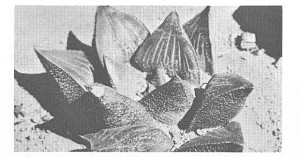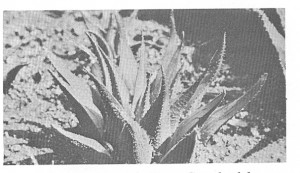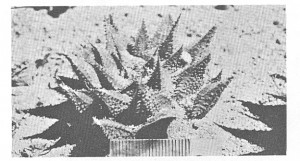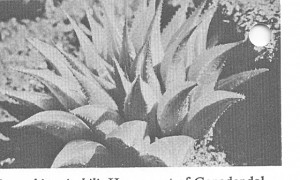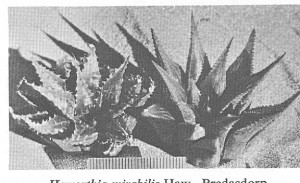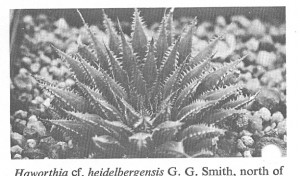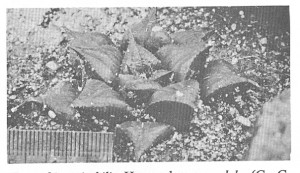Printed in Excelsa 7::37 (1977).
M.B.Bayer
Haworthia mirabilis was described by Haworth in 1804 from plants said to have been brought to England by the collector Francis Masson. It could thus have originated from practically anywhere in the southern and south-western Cape. Haworth referred to this species as the ‘rough cushion cushion’, and it was characterised by having retuse-deltoid leaves with ciliate-spinose margins and keels, the leaves being smooth on the face and the back surfaces almost tubercled and indistinctly reticulate. There is no extant type specimen and only the brief original description, and illustrations in Curtis’ Botanical Magazine (t 1354, 1811) and in Salm-Dyck’s Aloe Monograph (s9, t 1, 1836-49) serve to identify and typify the species.
In recent times, several references to H. mirabilis have been made, but only in the description of new species such as H. heidelbergensis G.G.Smith, H. mundula G.G.Smith and H. paradoxa Poelln. These comparisons carry very little weight as the actual origin and identity of H. mirabilis in relation to field populations was never clarified. Smith did use the name for a plant in his collection which came from Greyton in the S.W.Cape as had F. R. Long and H. Fourcade before. Von Poellnitz described H. triebnerana and H. willowmorensis in 1937 from plants sent to him by Triebner and bearing consecutive Triebner collecting numbers. The actual collection of the plants was attributed to Mrs. E. D. Helm in the Strydomsvlei and Willowmore area of the Eastern Little Karoo. Mrs. Helm (personal communication) claimed never to have collected in that area and also could not recall any plants of those names. Von Poellmtz subsequently produced a rash of varieties of H. triebnerana and all of these come from the extreme southwestern districts of the Cape and almost exclusively from south of the Riviersonderend mountains. The writer was unable to find any species remotely resembling H. triebnerana in the Strydomsvlei area. Similarly there is nothing known quite like H. willowmorensis illustrated in Sukkulentenkunde (1939) in the Willowmore district. C.L.Scott (Aloe, 1973) does equate this name with a notable variant of H. emelyae PoelIn. which occurs on the hills around Uniondale H. bayeri). However, there is little enough evidence to support this. The object of this article is therefore to review observations made on Haworthia in the southwestern districts of Caledon and Bredasdorp and releate these to Haworth’s missing species H. mirabilis and some subsequently described elements.
Collecting was done at many different localities including the type localities for H. badia Poelln., H. mundula Smith, the H. triebnerana varieties var. pulchra Poelln., var. depauperata Poelln., var. lanceolata Triebner & Poelln., var. diversicolor Triebn. & Poelln., var. turgida Triebn., var. sublineata Poelln., var. rubrodentata Triebn. et Poelln., and var. multituberculata Poelln.; H. otzenii G.G.Smith, H. emelyae Poelln. and the var. beukmannii Poelln., H. heidelbergensis G.G.Smith, H. nitidula Poelln. and at a possible locality for H. rossouwii Poelln. Collecting also covered H. magnfica Poelln. (including H. maraisii Poelln., H. notabilis Poelln. and H. schuldtiana Poelln.) and other less obviously related species in the same and adjacent areas. It became clear during this investigation that there was in fact only one rather variable species in the area which could be allied with H. mirabilis. No imagination was required to envisage specimens particularly from around Greyton and Genadendal agreeing favourably with the illustrations of the species in Curtis’ Botanical Magazine or Salm-Dyck’s Monograph.
Circumscription on the basis of foliage characters alone is virtually impossible as leaf-shape, texture and attitude are so variable. The general facies of the plants is sufficiently consistent in the field and in cultivation to leave little doubt about the integrity of the species. The photographs accompanying this article demonstrate the range of forms which are encountered. Variability is on a geographic basis and the isolated populations show good consistency. Floral characters provide more positive evidence of this being a single species complex as flowering occurs from mid-January to the end of February. The flowers are characteristically pinkish-brown veined. The slender buds have sharply upcurved and distinctly bifid tips – the effect being to produce spreading of the upper outer perianth lobes with the tips closely plicate.
Several of the H. triebnerana varieties had originated from the same localities despite the general consistency in the localised populations and in the field it is very difficult to recognise significant differences between populations on which varieties could perhaps rest. The varieties pulchra, depauperata and lanceolata are from the one locality at Stormsvlei although von Poellnitz also recorded the latter variety from the Gouritz river east of Albertinia. It seems fairly obvious that despite seeing varietal differences in plants from one locality, von Poellnitz was confusing a plant from quite a different species with these. This same kind of thing happened on more than one occasion and collectors can thus be excused from experiencing difficulties in identifying their plants. Variability at Stormsvlei was not abnormal and there does not appear to be any criterion by which varieties can be distinguished there. The plants are generally smaller and with narrower longer leaves than elsewhere and while they are easily separated from the large forms at Skuitsberg (which von Poellnitz described as H. emelyae var. beukmannii), this is only because extreme forms are being considered. The variety diversicolor occurs in the Robertson Karoo and is clearly an ecotype of H. maraisii and not associated with H. mirabilis directly. H. triebnerana var. nitida Poelln. is recorded only from Bonnievale and there can be no certainty as to actual identity. There are unconfirmed reports of H. mirabilis east of Drew which the writer has not been able to find, which could possibly still be the origin of this variety. The four varieties subtuberculata, multituberculata, napierensis and turgida are normal variants of H. mirabilis from the vicinity of Napier and if recognised would put naming of plants on a kind of christian name basis. In this area the plants are moderately variable as one would expect in any normal breeding population although the leaves are generally shorter and more erect than is the case in the northernmost populations. At Bredasdorp the var. sublineata is similarly variable and the type population is comprised predominantly of comparatively small plants with narrow leaves which may or may not be smooth-faced with up to 5 distinct lines. Immediately north of the town, however, the plants are more robust with fewer leaves and occasional plants have abruptly recurved leaves. In the case of var. rubrodentata at Genadendal the plants are again fairly variable, some having elongate narrow leaves with very red marginal teeth and tubercles which are characteristics not confined to this locality, and others are quite squat with greenish-white teeth. Recurvature of the leaves is apparently often a phenotypic character in some cases and is influenced by cultivation factors.
H. emelyae Poelln. was described from plants submitted by Mrs. Emelya Ferguson and the locality was not given. It transpires that the actual collector was a Mrs. Le Roux from Vanwyksdorp and that the plants were collected in the vicinity of the town. G.G.Smith’s collecting records indicate fairly conclusively that this was the case. The name can thus be associated with a species widespread but rare in the Little Karoo for which the name H. picta Poelin. was also used. It is only related to H. mirabilis through continuity with H. magnifica var. major (G.G.Smith) Bayer and has a large white flower without the conspicuous ‘fish-tail’ buds. H. emelyae var. beukmannii on the other hand was collected north of Caledon and von Poellnitz wrote to G.J.Payne… “I have forgotten to publish it, but I think it best to publish it only as a variety of H. emelyae”. It is quite evidently a variant of H. mirabilis and the fact that von Poellnitz did not associate it even with his other H. triebnerana varieties must be a message for someone.
H. nitidula Poelln. was cited “in the environs of Worcester, Caledon, Bredasdorp and Robertson, without precise locality, Maj. H. Venter”. All Venter’s collections were cited in this fashion and so it was rather a relief to find that G.G.Smith has Venter’s “No. 15” unequivocally recorded from Greyton. Smith applied the name to individual plants from at least three different species including his own H. longibracteata (= H. retusa). Recently acquired papers of Smith’s even indicate that he was contemplating publishing several more varieties of H. nitidula. Fortunately this name can be recognised to be synonomous with H. mirabilis.
H. rossouwii is something of an anomaly as Mr. Payne informed the writer that he had in fact discovered the species and requested that it be named after Mr. Rossouw. Payne also pointed out that the name was published from Triebner’s number 1059 and that Triebner later described H. altilinea var. bicarinata with the same collecting number. There is nothing in the brief collecting record kept by Payne to confirm all this and Payne’s recollection that he actually collected H. rossouwii at the same place as H. mundula is worth noting (personal communication). Payne did state that he had also collected at a locality north of Bredasdorp which he had not recorded. This is a locality which Otzen had also known and where three species occur. One of these is undeniably related to H. magnfica, the second is related to H. reticulata/turgida and the third is dubiously related to H. heidelbergensis or possibly to H. mirabilis itself. In the absence of a type it is unlikely that this problem can be adequately resolved and it is best to assume that H. rossouwii originated from the same locality as H. triebnerana var. sublineata and dismiss it as a synonym of H. mirabilis too.
Haworthia badia occurs in macchia vegetation in acid sandstone-derived soils west of Napier and is obviously an ecotype of H. mirabilis adapted to this situation. At its easterly limit, which is the type locality, the leaves are strongly recurved and the plants can be very large with a characteristic golden colour when exposed to direct sun. Further west the plants are smaller and the relation to H. mirabilis more evident. H. mundula similarly appears to be an ecotype isolated geographically from the main body of the species. It occurs in coastal macchia vegetation in shallow soils probably of the pebbly Witteberg series. It is very proliferous, rather small and the leaves are short and abruptly recurved. Colouration is variable from light yellow in their very exposed native habitat to very nearly black in cultivation. The spines may also be very red as described for H. triebnerana var. rubrodentata. Both H. badia and H. mundula are ibid. best regarded as geographic variants and subspecies of H. mirabilis.
The writers concept is therefore given as follows:-
Haworthia mirabilis Haworth Syn. P1. Succ. p. 95 (1812).
(Pictotype Curtis’ Botanical Magazine ibid. t 1354, 1811).
Aloe mirabilis Haw. in Trans. Linn. Soc.7:9 (1804).
Haworthia triebnerana Poelln. in Feddes Repert. Spec. Nov. 41:214 (1937).
var. depauperata Poelln. ibid. 43:94 (1938).
var. multituberculata Poelln. ibid. 44:135 (1938).
var. sublineata Poelln. ibid.
var. napierensis Triebn. & Poelln. ibid. 47:10 (1939).
var. lanceolata Triebn. & Poelln. ibid.
var. rubrodentata Triebn. & Poelln. ibid.
var. subtuberculata Triebn. & Poelln. ibid. 47:11(1939).
var. turgida Triebn. ibid.
var. pulchra Poelln. ibid. 49:28 (1940).
Haworthia willowmorensis Poelln. ibid. 41:216 (1937).
Haworthia rossouwii Poelln. in Kakteenkunde 7:75 (1938). (now H. rossouwii)
Haworthia nitidula Poelln. in Desert Pl. Life 11:192 (1939).
Rosette acaulescent, 2-10 cm in diameter, 8-30 leaves. Stem thick, white-fleshed, non-fibrous, 1/5 diam. of rosette, never elongate, slowly proliferous from base. Roots thick, firm, white-fleshed, non-fibrous. Leaves erect to recurved spreading, incurved only at extreme tips, firm to rigid, up to 70 mm long, 6-25 mm broad, 5-18 mm thick, oblong to ovate-lanceolate, acuminate to acute with end-awn up to 3 mm long, dark yellowish-green to red-brown, 1-5 longitudinal lines, face flat toward base, slightly convex above, smooth to denticulate, translucent in upper third, occasionally channelled, back convex, keeled in upper quarter, frequently with second keel, usually mottled above, margins acute, denticulate, spines red to white, generally less than 1 mm long, 1 mm apart, erect to retrorse.
Perianth brownish-white, tube ascending, curved up to 16 mm long, obclavate, rounded triangular at base, 3-4 mm across, reducing to 2-2,5 mm, segments free, outer segments valvate, inner imbricate, ends of outer upper lobes plicate, both margins of inner lower segments incurved from perianth mouth to tips.
Buds slightly biarcuate, slender, tips sharply reflexed upwards, markedly bifid. Flowering Jan.-Feb.
Haworthia mirabilis subsp badia (Poelln.) Bayer (Poelln.) Bayer, Haworthia Handbook, National Botanic Gardens of South Africa (1976).
Haworthia badia Poelln. in Kakteenkunde 7: 76 (1936). (Pictotype). Rosette large, 5-10 cm in diameter, up to 12 leaves, slowly proliferous, leaves 4-8 cm long, 1,5-2,5 cm wide, markedly recurved, oblong-elongate below, acuminate above, face smooth partly channeled, back very rounded, keeled at tip, margins mildly denticulate.
Haworthia mirabilis subsp. mundula (G.G.Smith) Bayer, Haworthia Handbook, National Botanic Gardens of South Africa (1976).
Haworthia mundula G. G. Smith in Jl. S. Afr. Bot. 12: 8 (1946). (Type G.G.Smith 5479, N.B.G.). Rosette small, 4-6 cm in diameter, up to 16 leaves, very proliferous, leaves 3-4 cm long, 1,5 cm wide, markedly recurved, acute above, back rounded, keeled at tip, face generally smooth, margins with teeth up to 0,5mm long.
The entire complex of the “retuse” haworthias is a difficult one and there are no absolute limits to the different elements which can be recognised. H. mirabilis occurs in an area geographically adjacent to that of H. magnifica and obviously these two species are very closely allied. (Here I was caught up in the problem of trying to decide if maraisii and magnifica were separate species or not – currently I am of the opinion that both should be included in an greatly expanded concept of H. mirabilis which could even include H, heidelbergensis). Both species occur at Stormsvlei where they appear to be discrete, whereas 12 km south there is a population which is possibly of hybrid origin.
H. magnifica itself is more widespread and variable than H. mirabilis and can be followed continuously through varied scattered populations to H. retusa (L.) Duval, H. emelyae, and even perhaps H. herbacea (Mill.) Stearn and H. turgida Haw. Similarly H. retusa can be seen to be continuous with
H. turgida, H. turgida with H. reticulata Haw. and H. reticulata with H. herbacea. Within the complex there are odd elements which do not fit adequately into a species concept of this kind and are regarded as discrete e.g. H. heidelbergensis, H. pubescens Bayer, H. maculata (Poelln.) Bayer and H. serrata Bayer.
(It should be noted that in my revision of 1999, I relate the type of H. mirabilis to the population from which mundula was drawn, and I also discard the pretentious differentiation of the subspecies rank. My current thinking that any formal rank at this level of identification is possily pointless and that it would be better for botany if collectors an pretender taxonomists simply added names between inverted commas for all these taxa which have no reality in botanical terms.)
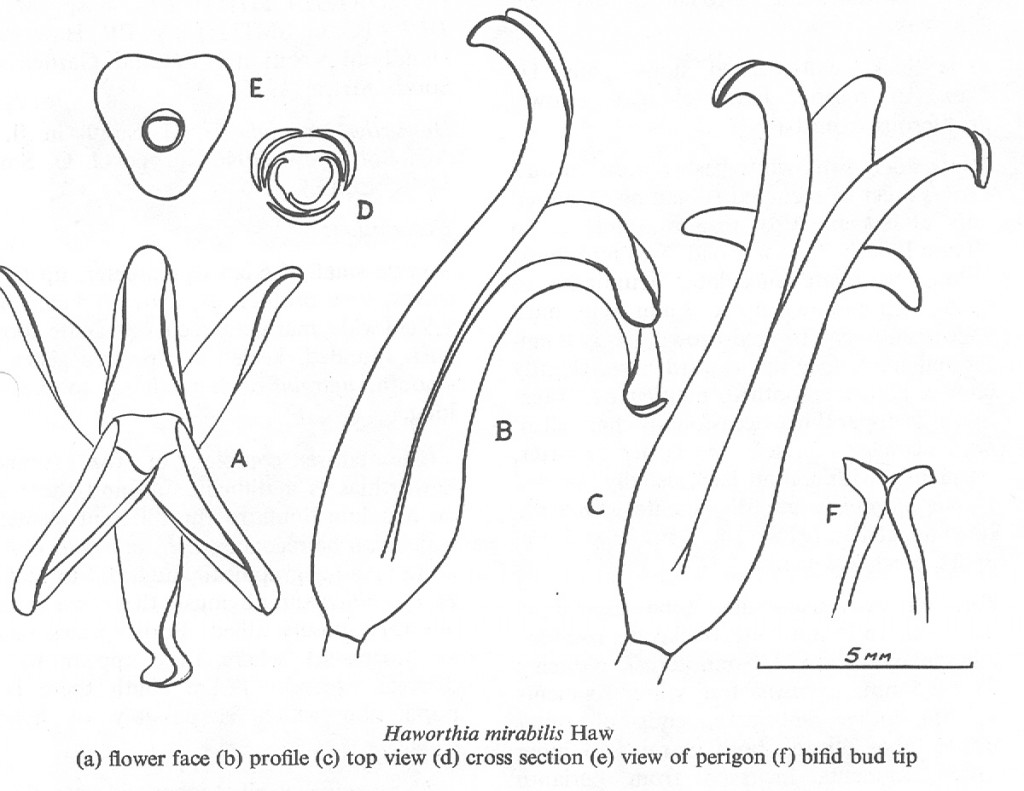
Fig. 1. Haworthia mirabilis Haw. (a) flower face; (b) profile (c) top view (d) cross section (e) view of perigon (f) bifid bud tip.

